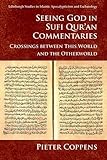Seeing God in Sufi Qur’an Commentaries : Crossings between This World and the Otherworld / Pieter Coppens.
Material type: TextSeries: Edinburgh Studies in Islamic Apocalypticism and Eschatology : ESIAEPublisher: Edinburgh : Edinburgh University Press, [2022]Copyright date: ©2018Description: 1 online resource (304 p.)Content type:
TextSeries: Edinburgh Studies in Islamic Apocalypticism and Eschatology : ESIAEPublisher: Edinburgh : Edinburgh University Press, [2022]Copyright date: ©2018Description: 1 online resource (304 p.)Content type: - 9781474435079
- 297
- BP130.4 .C664 2018
- online - DeGruyter
| Item type | Current library | Call number | URL | Status | Notes | Barcode | |
|---|---|---|---|---|---|---|---|
 eBook
eBook
|
Biblioteca "Angelicum" Pont. Univ. S.Tommaso d'Aquino Nuvola online | online - DeGruyter (Browse shelf(Opens below)) | Online access | Not for loan (Accesso limitato) | Accesso per gli utenti autorizzati / Access for authorized users | (dgr)9781474435079 |
Frontmatter -- Contents -- Figures and Tables -- Abbreviations -- 1 Introduction -- 2 Sufi Qur’an Commentaries: The Rise of a Genre -- 3 The Ultimate Boundary Crossing: Paradise and Hell in the Commentaries -- 4 The First Boundary Crossing: Adam Descending -- 5 Excursus: Embodying the Vision of God in Theology and Sufism -- 6 Arinī: Declined at the Boundary? -- 7 A Vision at the Utmost Boundary -- 8 Conclusion -- Bibliography -- Index
restricted access online access with authorization star
http://purl.org/coar/access_right/c_16ec
Discusses the concept of the vision of God in Sufi Qur’an CommentariesFirst in-depth study of the concept of the vision of God in Sufi eschatology, not only focusing on the hereafter, but also on this-worldly visionCompares five understudied tafsīr sources, gaining new insights into the genre of Sufi tafsīr and its intertextualityFirst study that intensively deals with the yet unpublished Qur’an commentary of Shams al-Dīn al-DaylamīIncludes detailed descriptions of Sufi imaginations of Paradise and Hell and discussions of Qur’anic passages on Adam, Moses and Muhammad related to seeing GodThis history of Sufi conceptions of the hereafter – often imagined as a place of corporeal reward (Paradise) or punishment (Hell) – is built upon the study of five medieval Sufi Qur’an commentaries. Pieter Coppens shows that boundary crossing from this world to the otherworld, and vice versa, revolves around the idea of meeting with and the vision of God; a vision which for some Sufis is not limited to the hereafter. The Qur’anic texts selected for study – all key verses on seeing God – are placed in their broader religious and social context and are shown to provide a useful and varied source for the reconstruction of a history of Sufi eschatology and the vision of God.
Mode of access: Internet via World Wide Web.
In English.
Description based on online resource; title from PDF title page (publisher's Web site, viewed 29. Jul 2022)


